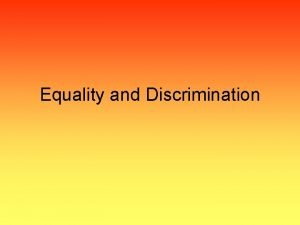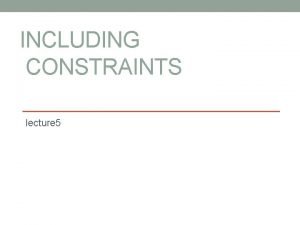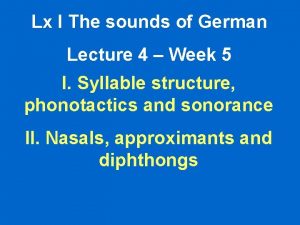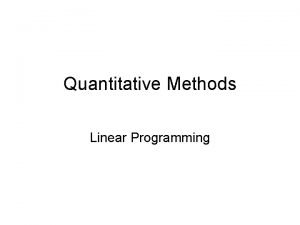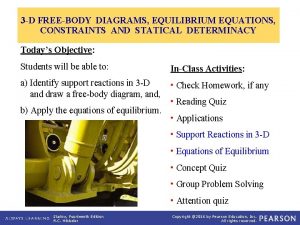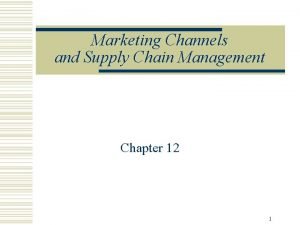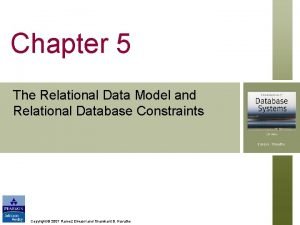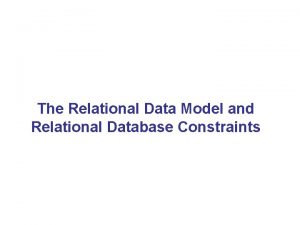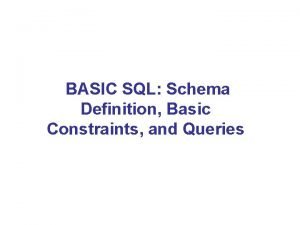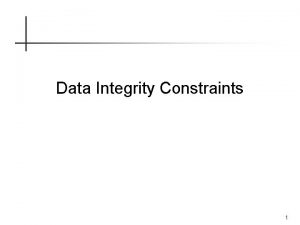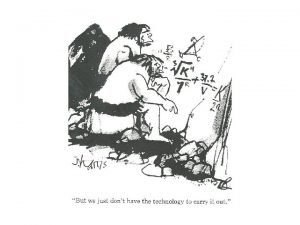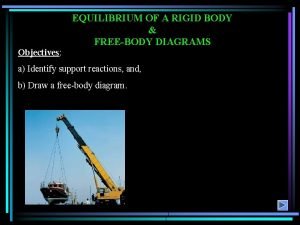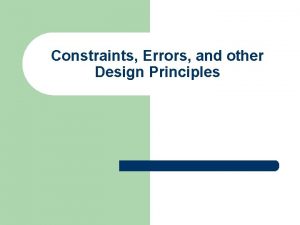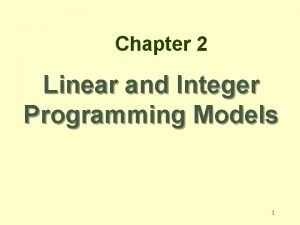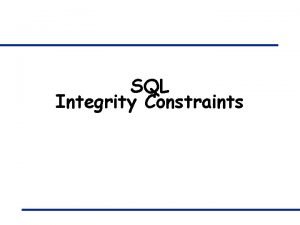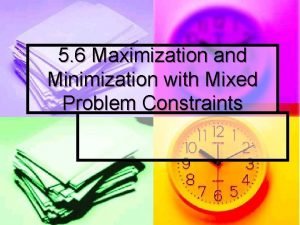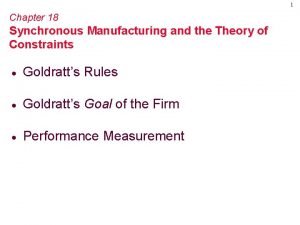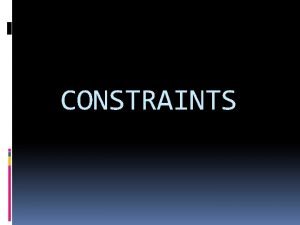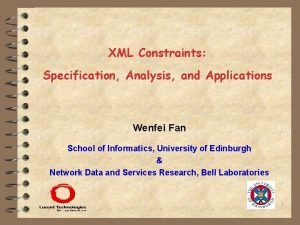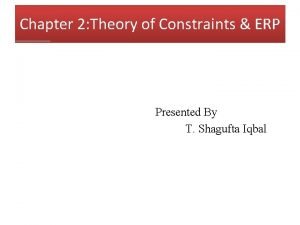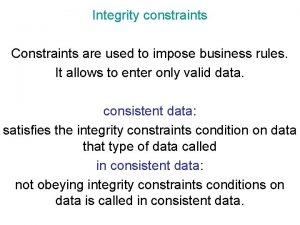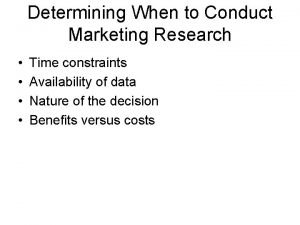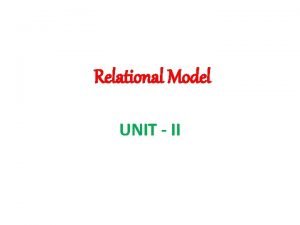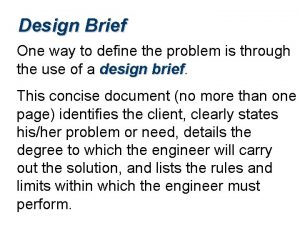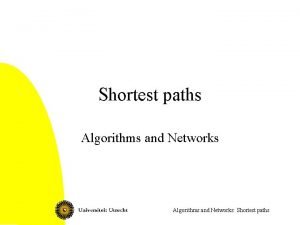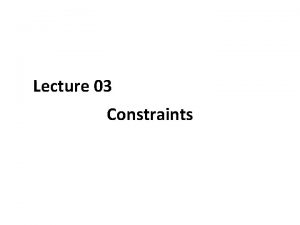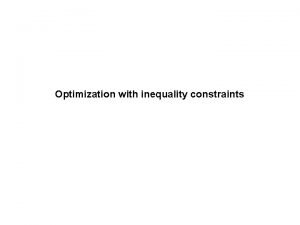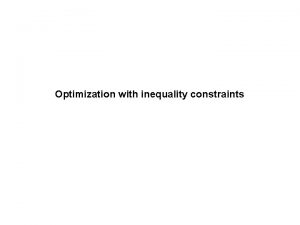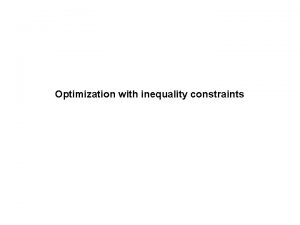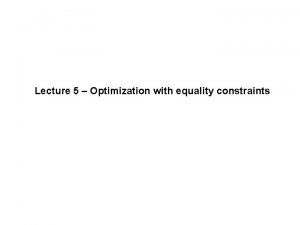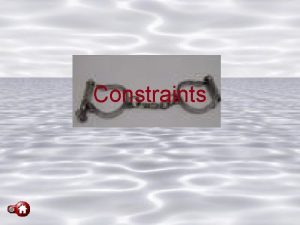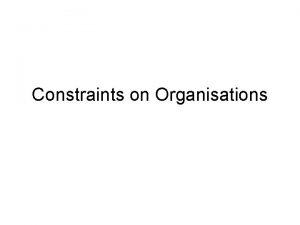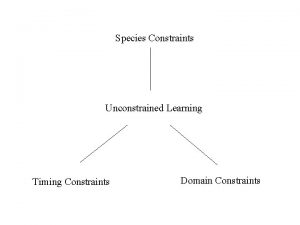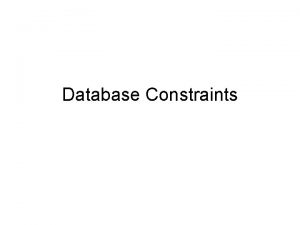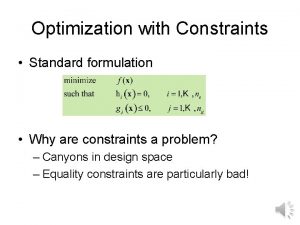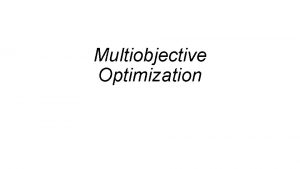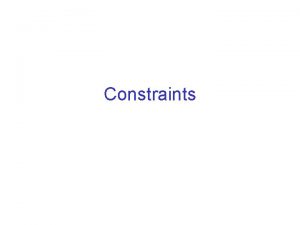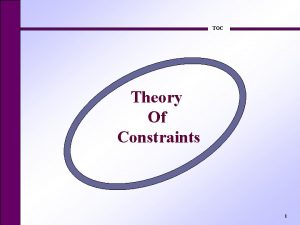Ch 12 Optimization with Equality Constraints 12 1






















































- Slides: 54

Ch. 12 Optimization with Equality Constraints • • • 12. 1 12. 2 12. 3 12. 4 12. 5 Demand • 12. 6 • 12. 7 • 12. 8 Effects of a Constraint Finding the Stationary Values Second-Order Conditions Quasi-concavity and Quasi-convexity Utility Maximization and Consumer Homogeneous Functions Least-Cost Combination of Inputs Some concluding remarks 1

2

3

4

5

12. 2 -2 Total-differential approach • • d. L = fxdx + fydy = 0 differential of L=f(x, y) dg = gxdx + gydy = 0 differential of g=g(x, y) dx & dy dependent on each other dy/dx = -fx/ fy slope of isoquant curve dy/dx = -gx/gy slope of the constraint line -gx /gy = -fx/ fy equal at the tangent fx/ gx = fy /gy = equi-marginal principle 6

7

8

9

10

11

12

13

12. 2 Finding the Stationary Values • 12. 2 -1 Lagrange-multiplier method • 12. 2 -2 Total-differential approach • 12. 2 -3 An interpretation of the Lagrange multiplier • 12. 2 -4 n-variable and multi-constraint case 14

12. 2 -1 Lagrange-multiplier method 15

12. 2 -2 Total-differential approach • • d. L = fxdx + fydy = 0 differential of L=f(x, y) dg = gxdx + gydy = 0 differential of g=g(x, y) dx & dy dependent on each other dy/dx = -fx/ fy slope of isoquant curve dy/dx = -gx/gy slope of the constraint line -gx /gy = -fx/ fy equal at the tangent fx/ gx = fy /gy = equi-marginal principle 16

17

18

12. 3 • • • Second-Order Conditions 12. 3 -1 Second-order total differential 12. 3 -2 Second-order conditions 12. 3 -3 The bordered Hessian 12. 3 -4 n-variable case 12. 3 -5 Multi-constraint case 19

11. 4 n-variable soc principal minors test for unconstrained max or min 20

12. 3 -1 Second-order total differential • has no effect on the value of Z* because the constraint equals zero but … • A new set of second-order conditions are needed • The constraint changes the criterion for a relative max. or min. 21

12. 3 -1 Second-order total differential 22

12. 3 -1 Second-order total differential 23

24

25

26

12. 4 Quasi-concavity and Quasi-convexity • • 12. 4 -1 Geometric characterization 12. 4 -2 Algebraic definition 12. 4 -3 Differentiable functions 12. 4 -4 A further look at the bordered Hessian • 12. 4 -5 Absolute vs. relative extrema 27

12. 5 Utility Maximization and Consumer Demand • • 12. 5 -1 First-order condition 12. 5 -2 Second-order condition 12. 5 -3 Comparative-static analysis 12. 5 -4 Proportionate changes in prices and income 28

29

30

31

32

33

34

35

36

37

38

Graph: Substitution and Income Effects Quantity Q 2 P 0 If the price of Q 1 increases, then the change in demand equals the substitution effect (AB) and the income effect (BC). P 0 B A C U 0 U 1 P 1 P 0 Quantity Q 1 39

Graph: Substitution and Income Effects Quantity Y -Px 1/Py 0 If the price of Q 1 increases, then the change in ordinary demand equals the sum of the substitution effect (AB) and the income effect (BC). B Y 1' Y 0 Y 1 A C U 0 U 1 -Px 1/Py 0 -Px 0/Py 0 Quantity X Price X P 1 P 0 Ordinary demand Compensated demand X 1' X 0 40 Quantity X

12. 7 • • Least-Cost Combination of Inputs 12. 7 -1 First-order condition 12. 7 -2 Second-order condition 12. 7 -3 The expansion path 12. 7 -4 Homothetic functions 12. 7 -5 Elasticity of substitution 12. 7 -6 CES production function 12. 7 -7 Cobb-Douglas function as a special case of the CES function 52

53

54

55

56

57

12. 7 -6 CES production function 64

12. 7 -6 CES production function 65

12. 7 -6 CES production function 66

12. 7 -6 CES production function 67

12. 7 -6 CES production function 68

12. 7 -6 CES production function 69

12. 7 -6 CES production function 70

12. 7 -6 CES production function 71
 Formal equality vs substantive equality
Formal equality vs substantive equality Formal and substantive equality
Formal and substantive equality What are contraints
What are contraints Participation constraints in dbms
Participation constraints in dbms Progressing emergent constraints on future climate change
Progressing emergent constraints on future climate change Phonotactic constraints
Phonotactic constraints Linear programming in quantitative techniques
Linear programming in quantitative techniques Menu rationalization
Menu rationalization Realistic constraints
Realistic constraints Don norman constraints
Don norman constraints Example of environmental constraints
Example of environmental constraints Constraints and statical determinacy
Constraints and statical determinacy Jean charles regin
Jean charles regin Channel management decisions in marketing
Channel management decisions in marketing Design constraints of embedded system
Design constraints of embedded system Relational model constraints
Relational model constraints Relational database constraints
Relational database constraints Basic constraints in sql
Basic constraints in sql List three of the commonly used assembly constraints
List three of the commonly used assembly constraints Gtt design process
Gtt design process Biba n 445 ddl
Biba n 445 ddl Holonomic constraints
Holonomic constraints Quadruple constraint
Quadruple constraint Marriages and families changes choices and constraints
Marriages and families changes choices and constraints Improperly constrained
Improperly constrained Constraints design principle
Constraints design principle Non negativity constraints
Non negativity constraints Conversational constraints theory
Conversational constraints theory Semantic constraints in hci
Semantic constraints in hci Quadruple constraints in project management
Quadruple constraints in project management Biba n 421 ddl
Biba n 421 ddl Accounting constraints
Accounting constraints Monitoring and evaluation challenges
Monitoring and evaluation challenges Shortest path linear programming
Shortest path linear programming Big m method minimization example
Big m method minimization example Nx sketch constraints
Nx sketch constraints Synchronous manufacturing
Synchronous manufacturing Holonomic and nonholonomic constraints examples
Holonomic and nonholonomic constraints examples Design is achieving goals within constraints
Design is achieving goals within constraints Quadruple constraints in project management
Quadruple constraints in project management Xml constraints
Xml constraints Plcms
Plcms Theory of constraints
Theory of constraints Cultural constraints on managers
Cultural constraints on managers Data integrity constraints are used to:
Data integrity constraints are used to: In a marketing decision constraints are
In a marketing decision constraints are Marriages and families changes choices and constraints
Marriages and families changes choices and constraints Relational constraints in dbms
Relational constraints in dbms Problem brief example
Problem brief example Inventory management accounting
Inventory management accounting Difference constraints and shortest paths
Difference constraints and shortest paths Cost constraint in accounting
Cost constraint in accounting Biological constraints example
Biological constraints example Cultural constraints in management theories
Cultural constraints in management theories Instinctive drift example
Instinctive drift example
